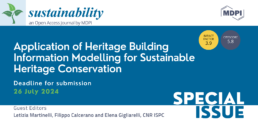CNR ISPC Special Issue of “Sustainability” by MDPI on the conservation of built heritage
Now online the Special Issue “Application of Heritage Building Information Modelling for Sustainable Heritage Conservation”, directed by Letizia Martinelli, Filippo Calcerano and Elena Gigliarelli (CNR ISPC), within the open access Journal Sustainability by MDPI.

The relevance of sustainable methodologies and practices for the conservation of built heritage is currently gaining traction.
Built heritage is not the most energy-intensive part of the building stock, thanks to its passive design optimised for the reference climate; however, climate change is weakening this assumption, intensifying the risk of damage and decay, raising operation costs and limiting use. On the other hand, built heritage can act as a driver for sustainability, thanks to its potential for mobilising the scientific community and society towards decarbonisation and circular economy.
Heritage Building Information Modeling (HBIM) represents one of the most promising of such processes for sustainable conservation, as it fosters interdisciplinarity, stakeholder involvement, efficient workflows, feasible analysis and performance-based design solutions. Despite this potential, many gaps still need to be addressed to fully exploit HBIM-based processes for sustainable heritage conservation, related to methodologies, software applications, and built heritage’s inherent complexities.
This special issue seeks contributions that examine in depth both the theoretical and methodological implications of the application of HBIM for sustainable Heritage Conservation.
Relevant topics to this Special Issue include:
- Methodologies and applications of HBIM for sustainable heritage protection to relevant case studies
- Energy and environmental improvement of historical buildings and sensitive renovation through HBIM: analyses, diagnostics, interventions
- HBIM support of sustainable operation and maintenance
- Interoperability between HBIM and Building Performance Simulation
- HBIM and IoT to support sustainable heritage protection
- HBIM approaches to prevent maladaptation
- Sustainable asset management through the use of HBIM for public authorities involved in heritage conservation and enhancement
- HBIM support for ecological compatibility and circular economy within conservation processes (materials, tools, etc.)
- Evaluation of environmental impacts and risks and integration of decision-support systems within HBIM processes
- Analysis through HBIM of strategies and construction techniques traditionally implemented in historical buildings to optimise they energy and environmental behaviour and comfort depending on local climate
Deadline for manuscript submissions: 26 July 2024
